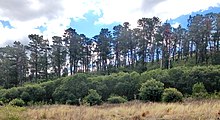Conifer
Examples include cedars, Douglas-firs, cypresses, firs, junipers, kauri, larches, pines, hemlocks, redwoods, spruces, and yews.They are the dominant plants over large areas of land, most notably the taiga of the Northern Hemisphere, but also in similar cool climates in mountains further south.While tropical rainforests have more biodiversity and turnover, the immense conifer forests of the world represent the largest terrestrial carbon sink.[7] Major fossil orders of conifers or conifer-like plants include the Cordaitales, Vojnovskyales, Voltziales and perhaps also the Czekanowskiales (possibly more closely related to the Ginkgophyta).[14] All living conifers are woody plants, and most are trees, the majority having a monopodial growth form (a single, straight trunk with side branches) with strong apical dominance.Many conifers have distinctly scented resin, secreted to protect the tree against insect infestation and fungal infection of wounds.Fossilized resin hardens into amber, which has been commercially exploited historically (for example, in New Zealand's 19th-century kauri gum industry).[20] The oldest non-clonal living tree is a Great Basin bristlecone pine (Pinus longaeva), 4,700 years old.The leaves are often dark green in colour, which may help absorb a maximum of energy from weak sunshine at high latitudes or under forest canopy shade.The microscopic structure of conifer wood consists of two types of cells: parenchyma, which have an oval or polyhedral shape with approximately identical dimensions in three directions, and strongly elongated tracheids.The tracheids of earlywood formed at the beginning of a growing season have large radial sizes and smaller, thinner cell walls.In Pinaceae, Araucariaceae, Sciadopityaceae and most Cupressaceae, the cones are woody, and when mature the scales usually spread open allowing the seeds to fall out and be dispersed by the wind.In the families Podocarpaceae, Cephalotaxaceae, Taxaceae, and one Cupressaceae genus (Juniperus), the scales are soft, fleshy, sweet, and brightly colored, and are eaten by fruit-eating birds, which then pass the seeds in their droppings.The gymnosperm male gametophytes (pollen grains) are carried by wind to a female cone and are drawn into a tiny opening on the ovule called the micropyle.[citation needed] Conifers are heterosporous, generating two different types of spores: male microspores and female megaspores.Conifers are classified by three reproductive cycles that refer to the completion of female strobilus development from initiation to seed maturation.One year reproductive cycle: The genera include Abies, Picea, Cedrus, Pseudotsuga, Tsuga, Keteleeria (Pinaceae) and Cupressus, Thuja, Cryptomeria, Cunninghamia and Sequoia (Cupressaceae).[27] Conifers are the dominant plants over large areas of land, most notably the taiga of the Northern Hemisphere,[1] but also in similar cool climates in mountains further south.The species is widely regarded as an environmental weed across southeastern and southwestern Australia[31] and the removal of individual plants beyond plantations is encouraged.[32] At least 20 species of roundheaded borers of the family Cerambycidae feed on the wood of spruce, fir, and hemlock (Rose and Lindquist 1985).One of the most common and widely distributed borer species in North America is the whitespotted sawyer (Monochamus scutellatus).Adults are found in summer on newly fallen or recently felled trees chewing tiny slits in the bark in which they lay eggs.The eggs hatch in about two weeks and the tiny larvae tunnel to the wood and score its surface with their feeding channels.Early in the spring of the second year following egg-laying, the larvae, about 30 mm long, pupate in the tunnel enlargement just below the wood surface.The resulting adults chew their way out in early summer, leaving round exit holes, so completing the usual 2-year life cycle.Durzan and Steward noted that their results, drawn from determinations made in late summer, did not rule out the occurrence of different interim responses at other times of the year.Many nursery managers were long reluctant to apply nitrogenous fertilizers late in the growing season, for fear of increased danger of frost damage to succulent tissues.Values are influenced by environmental factors and interactions among the 16 nutrient elements known to be essential to plants, 13 of which are obtained from the soil, including nitrogen, phosphorus, potassium, calcium, magnesium, and sulfur, all used in relatively large amounts.The softwood derived from conifers is of great economic value, providing about 45% of the world's annual lumber production.










Conifer (disambiguation)PreꞒCarboniferousPresentforestAbies albaVosgesFranceScientific classificationPlantaeTracheophytesGymnospermaeCupressidaeAraucarialesAraucariaceaePodocarpaceaeCupressalesSciadopityaceaeCupressaceaeTaxaceaePinidaePinalesPinaceaeCheirolepidiaceaeGnetidaePalissyalesVoltzialesCordaitalesSynonymscone-bearingseed plantsgymnospermsdivisionextantperennialwoody plantssecondary growthshrubscedarsDouglas-firscypressesjuniperslarcheshemlocksredwoodssprucesecologicallyNorthern Hemispheretropical rainforestsbiodiversitycarbon sinksoftwoodlumberKainuu regionFinlandInternational Code of Nomenclature for algae, fungi, and plantsdescriptive botanical namesConiferalesTaxalesDNA sequencesparaphyleticmorphologycladisticmolecular dataCephalotaxaceaePhyllocladaceaeTaxodiaceaefossilPaleozoicMesozoicherbaceousCzekanowskialesGinkgophytaGnetophytasister groupPennsylvanianwalchian conifersPermianCisuralianvoltzialeanPermian–Triassic extinction eventJurassicLate Cretaceousadaptive radiationflowering plantsTāne MahutaWaipoua ForestNew Zealandapical dominanceinsectfungalkauri gumcoast redwoodEucalyptus regnansangiospermstree with the greatest trunk diameterMontezuma cypressSequoiadendron giganteumpygmy pinePinus longaevaPseudotsuga menziesii var. menziesiiAraucaria columnarisAbies grandisLawson's cypressleavesAgathisNageiaPinus engelmanniistomatalatitudesPinus brutiablue spruceultravioletevergreenPseudolarixGlyptostrobusMetasequoiaTaxodiumdeciduousstructuregrowing seasoncell wallsConifer conewind-pollinatedstrobiluspine nuts